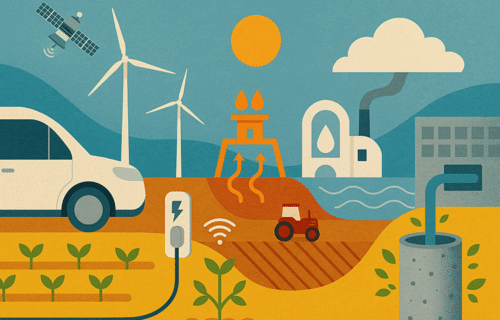A new global report highlights ten technologies that could reshape how societies produce food, generate energy, manage water, and build cities in response to climate change. The study, published by the World Economic Forum in partnership with scientific publisher Frontiers, calls for rapid scaling of existing innovations that could help stabilize environmental systems and support sustainable growth.
The 10 Emerging Technology Solutions for Planetary Health report draws on expert research and data modelling to identify technologies that can both reduce emissions and strengthen ecosystems. The list includes carbon-storing concrete, precision fermentation for food production, and next-generation desalination for water-scarce regions.
According to the authors, these solutions already exist but remain underused due to financial, regulatory, and infrastructure hurdles. They argue that combining technology with political commitment and cross-sector cooperation could help address several of the world’s most pressing environmental challenges.
Among the highlighted innovations is regenerative desalination, which uses renewable energy to turn seawater into drinking water with much lower energy consumption than traditional methods. Early pilot projects in Europe and North America suggest the approach could be vital for arid regions such as the Middle East.
Another promising field is modular geothermal power, designed to deliver constant renewable electricity using compact, factory-built units. Unlike wind or solar power, geothermal plants provide round-the-clock energy, offering stability to national grids.
In agriculture, soil health technologies—ranging from AI-based sensors to microbial soil treatments—aim to restore fertility and increase carbon storage. Meanwhile, methane capture systems are being developed to detect and convert leaks from farms and landfills, offering one of the fastest ways to slow global warming.
In construction, carbon-locking concrete could significantly lower emissions from the world’s most widely used building material by using recycled aggregates and trapping CO₂ permanently within the material.
The report stresses that technological progress alone will not deliver planetary stability. It points to the need for long-term investment, supportive policy, and open data-sharing among governments, industry, and academia. Without coordination, the authors warn, even the most promising technologies could stall at the pilot stage.
The analysis also shows how digital monitoring tools, such as advanced satellites and real-time Earth observation systems, are enabling faster detection of floods, droughts, and deforestation, improving disaster preparedness.
Jeremy Jurgens, Managing Director at the World Economic Forum, said the findings are meant to help global leaders “see what’s already within reach” and act decisively before environmental thresholds are crossed. Frederick Fenter, Chief Executive Editor at Frontiers, emphasized the importance of open scientific collaboration, describing innovation as a “collective exercise in planetary repair.”
The report’s release coincided with the Forum’s Annual Meeting of the Global Future Councils in Dubai, which gathered over 500 leaders to discuss how emerging technologies can be deployed responsibly. The authors note that these ten innovations, while diverse in scope, share a unifying goal: to replace extractive models with regenerative systems that benefit both people and planet.
The document serves as both a call to action and a roadmap—arguing that innovation, if scaled wisely, can still reverse some of the damage already done. The next phase, it concludes, depends not on invention but on the world’s willingness to act.
Source: WEF
